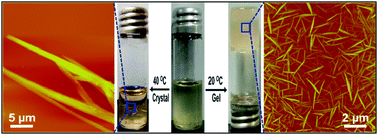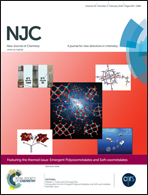Self-assembly of the polyoxometalate–cholesterol conjugate into microrods or nanoribbons regulated by thermodynamics†
Abstract
We reported that the self-assembly of the polyoxometalate–organic conjugate can be well controlled and regulated by means of a temperature-mediated approach. The conjugate comprised of an organically modified Anderson-type polyoxometalate cluster with two cholesterol moieties, considering that the symmetrical and rigid structure of the Anderson-type polyoxometalate cluster is an excellent building block for constructing functional supramolecular assemblies, and cholesterol is widely explored to fabricate desired self-assemblies, due to its planar structure together with the van der Waals interactions between molecules. Utilizing the temperature-mediated approach, the conjugate assembled into micrometre scale crystalline rods at 40.0 °C, and an organogel at 20.0 °C, in mixed DMF/toluene solvents (v/v = 1 : 9). For crystalline rods, they were constituted with a lot of ultralong and rigid microrods, and for organogel, it was immobilized by massive short and elongated nanoribbons. Moreover, a mechanism has been proposed to explain the self-assembly behavior of the conjugate at different temperatures. This temperature-mediated approach may provide a feasible method for the fabrication of nanostructural materials for various applications.

- This article is part of the themed collection: Emergent Polyoxometalates and Soft-oxometalates

 Please wait while we load your content...
Please wait while we load your content...